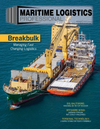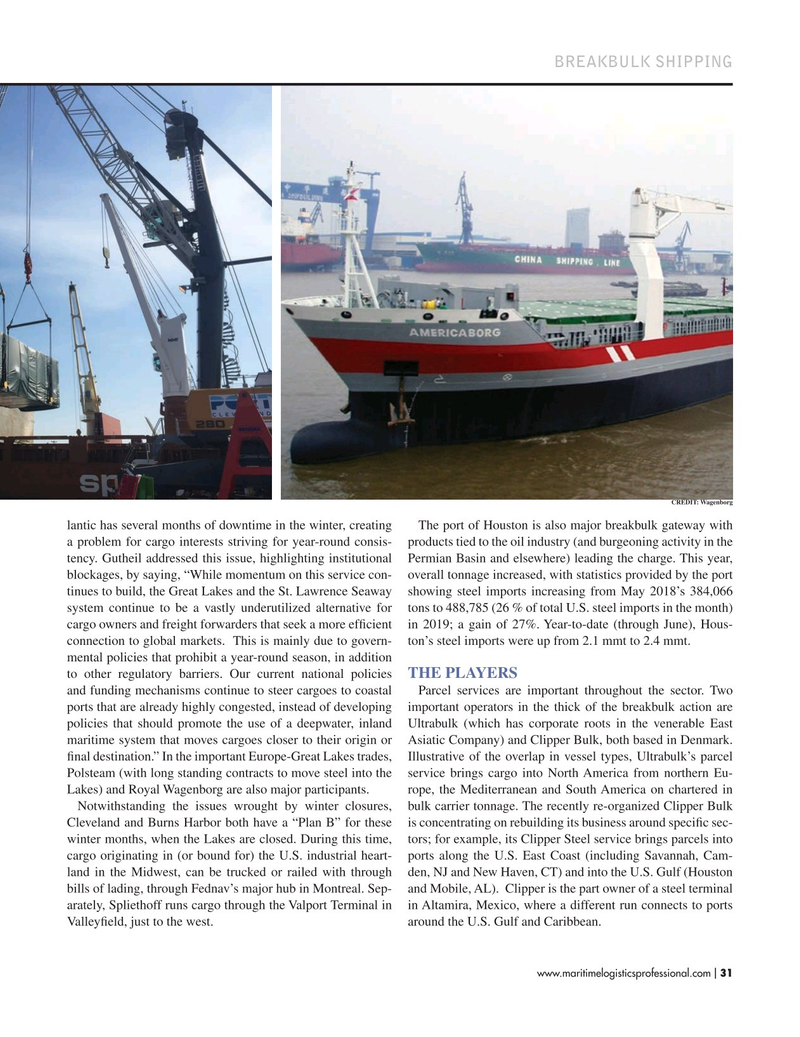
Page 31: of Maritime Logistics Professional Magazine (Jul/Aug 2019)
Breakbulk Issue
Read this page in Pdf, Flash or Html5 edition of Jul/Aug 2019 Maritime Logistics Professional Magazine
BREAKBULK SHIPPING
CREDIT: Wagenborg lantic has several months of downtime in the winter, creating The port of Houston is also major breakbulk gateway with a problem for cargo interests striving for year-round consis- products tied to the oil industry (and burgeoning activity in the tency. Gutheil addressed this issue, highlighting institutional Permian Basin and elsewhere) leading the charge. This year, blockages, by saying, “While momentum on this service con- overall tonnage increased, with statistics provided by the port tinues to build, the Great Lakes and the St. Lawrence Seaway showing steel imports increasing from May 2018’s 384,066 system continue to be a vastly underutilized alternative for tons to 488,785 (26 % of total U.S. steel imports in the month) cargo owners and freight forwarders that seek a more ef? cient in 2019; a gain of 27%. Year-to-date (through June), Hous- connection to global markets. This is mainly due to govern- ton’s steel imports were up from 2.1 mmt to 2.4 mmt. mental policies that prohibit a year-round season, in addition to other regulatory barriers. Our current national policies THE PLAYERS and funding mechanisms continue to steer cargoes to coastal Parcel services are important throughout the sector. Two ports that are already highly congested, instead of developing important operators in the thick of the breakbulk action are policies that should promote the use of a deepwater, inland Ultrabulk (which has corporate roots in the venerable East maritime system that moves cargoes closer to their origin or Asiatic Company) and Clipper Bulk, both based in Denmark. ? nal destination.” In the important Europe-Great Lakes trades, Illustrative of the overlap in vessel types, Ultrabulk’s parcel
Polsteam (with long standing contracts to move steel into the service brings cargo into North America from northern Eu-
Lakes) and Royal Wagenborg are also major participants. rope, the Mediterranean and South America on chartered in
Notwithstanding the issues wrought by winter closures, bulk carrier tonnage. The recently re-organized Clipper Bulk
Cleveland and Burns Harbor both have a “Plan B” for these is concentrating on rebuilding its business around speci? c sec- winter months, when the Lakes are closed. During this time, tors; for example, its Clipper Steel service brings parcels into cargo originating in (or bound for) the U.S. industrial heart- ports along the U.S. East Coast (including Savannah, Cam- land in the Midwest, can be trucked or railed with through den, NJ and New Haven, CT) and into the U.S. Gulf (Houston bills of lading, through Fednav’s major hub in Montreal. Sep- and Mobile, AL). Clipper is the part owner of a steel terminal arately, Spliethoff runs cargo through the Valport Terminal in in Altamira, Mexico, where a different run connects to ports
Valley? eld, just to the west. around the U.S. Gulf and Caribbean. www.maritimelogisticsprofessional.com 31
I

 30
30

 32
32
